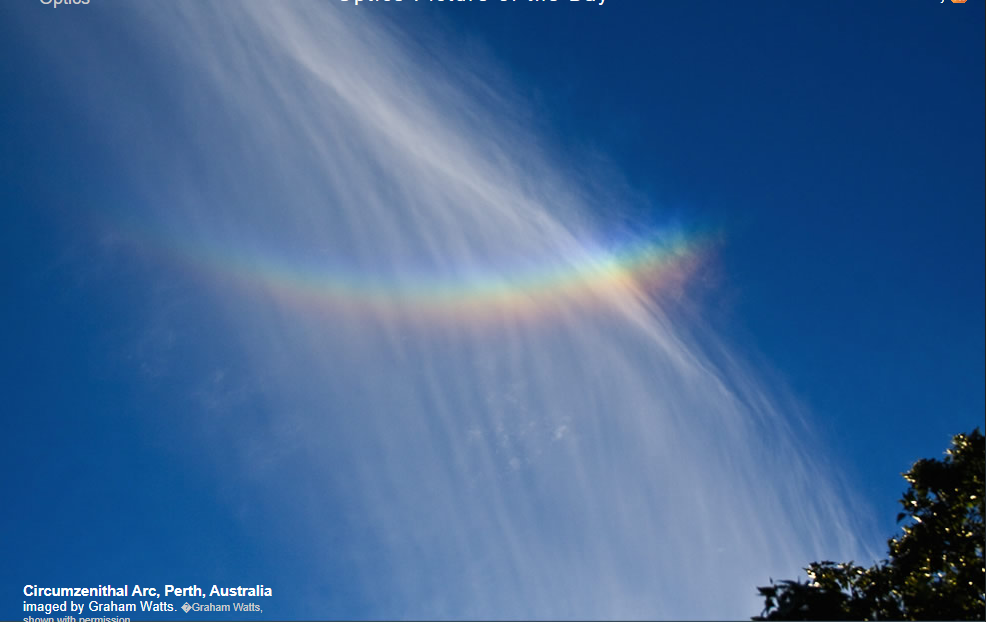Circumzenithal Arc
The Enchanting Phenomenon of the Circumzenithal Arc
Have you ever looked up at the sky and been captivated by a beautiful display of colors? One such mesmerizing atmospheric optics phenomenon is the Circumzenithal Arc (CZA). This celestial spectacle is formed by the collective glints of millions of plate crystals found in high cirrus clouds. As these crystals catch the sunlight, they illuminate the wisps of cirrus clouds, creating a breathtaking arc that seems to defy gravity.
The Circumzenithal Arc is a transient phenomenon that changes rapidly, making it even more fascinating to observe. In a matter of minutes, this ethereal arc can transform its appearance, captivating viewers with its ever-changing beauty. Typically, a CZA will alter its shape and color over less than a minute and remain visible for only a few minutes.
To witness a Circumzenithal Arc, you need to look upwards towards the zenith, which is the point directly overhead. It's important to note that the CZA is not a complete circle but rather an arc that appears above the zenith. Its shape resembles an upside-down rainbow, with vibrant colors stretching across the sky in an arc-like formation.
So, what causes this enchanting phenomenon to occur? The key lies in the unique properties of plate crystals present in cirrus clouds. These tiny ice crystals are shaped like flat plates and are aligned horizontally as they fall through the atmosphere. When sunlight passes through these plate crystals, it undergoes refraction, causing it to split into its component colors, similar to how a prism separates light into a spectrum.
As the light refracts through the plate crystals, it follows a complex path within the cloud, resulting in the formation of the Circumzenithal Arc. The intricate interplay of sunlight and ice crystals creates a stunning display of colors that can rival even the most vibrant rainbows.
Here are some additional intriguing facts about the Circumzenithal Arc:
- The colors of the CZA are typically more vivid and saturated than those of a traditional rainbow. This is because the light undergoes multiple reflections and refractions within the ice crystals, intensifying the color display.
- The CZA is often referred to as an "upside-down rainbow" due to its arc-like shape above the zenith. However, unlike rainbows, which form from water droplets, the CZA is formed by ice crystals.
- The angle of the sun plays a crucial role in the visibility of the Circumzenithal Arc. It is most commonly seen when the sun is relatively low in the sky, typically between 22 and 32 degrees above the horizon.
- The CZA is not limited to specific geographic locations. It can be observed worldwide, provided that the necessary conditions, such as high cirrus clouds and sunlight, are present.
- Occasionally, a secondary arc called the Supralateral Arc may appear alongside the Circumzenithal Arc. This secondary arc forms at a slightly lower angle and can further enhance the visual spectacle.
In conclusion, the Circumzenithal Arc is a stunning atmospheric optics phenomenon that showcases the beauty and complexity of nature. Its ever-changing appearance, vibrant colors, and ethereal nature make it a truly enchanting sight to behold. So, next time you find yourself gazing at the sky, remember to look upwards towards the zenith, and you might just be fortunate enough to witness this celestial masterpiece.

Circumzenithal Arc, Perth, Australia
imaged by Graham Watts. �Graham Watts, shown with permission.
Circumzenithal arcs change fast. These two images are 2 minutes apart.
The arc is the collective glints of millions of plate crystals in high cirrus cloud. The glints light the cirrus wisps and the resulting arc changes quickly as the cloud fragments transit the the zenith sky. Typically a CZA will alter its appearance over less than a minute and be visible over a few.

Note: this article has been automatically converted from the old site and may not appear as intended. You can find the original article here.
Reference Atmospheric Optics
If you use any of the definitions, information, or data presented on Atmospheric Optics, please copy the link or reference below to properly credit us as the reference source. Thank you!
-
<a href="https://atoptics.co.uk/blog/circumzenithal-arc-3/">Circumzenithal Arc</a>
-
"Circumzenithal Arc". Atmospheric Optics. Accessed on December 26, 2024. https://atoptics.co.uk/blog/circumzenithal-arc-3/.
-
"Circumzenithal Arc". Atmospheric Optics, https://atoptics.co.uk/blog/circumzenithal-arc-3/. Accessed 26 December, 2024
-
Circumzenithal Arc. Atmospheric Optics. Retrieved from https://atoptics.co.uk/blog/circumzenithal-arc-3/.